The 2015 LCGC Awards: Part 1
This year, we are pleased to honour an outstanding chromatographer, Joseph Jack Kirkland, as the winner of the 2015 LCGC Lifetime Achievement in Chromatography Award.
Since the founding of LCGC in 1983, we have made it our mission to serve the separation science community by publishing articles with a practical focus on improving chromatographic methods. Over the years, those articles have included many seminal works from leading analytical scientists who have made groundbreaking advances that have benefitted the entire community. Eight years ago, we decided to honour those leaders by establishing the LCGC Lifetime Achievement Award. The list of honorees is indeed an impressive one (Table 1). This year, we are once again pleased to honour an outstanding chromatographer: Joseph Jack Kirkland, the winner of the 2015 Lifetime Achievement in Chromatography Award. This year, we have the additional opportunity to honour Kirkland at Pittcon 2015 in an oral symposium as part of the Pittcon technical programme.
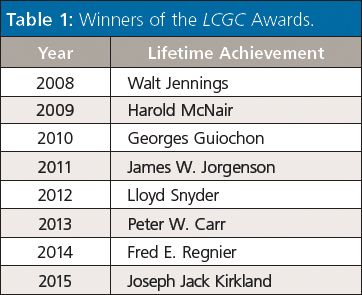
The English poet and artist William Blake once said "What is now proved was once only imagined". This quote is a fitting start to honour a man whose work was groundbreaking in so many aspects: Joseph Jack Kirkland. Kirkland, who is considered by many to be one of the fathers of high performance liquid chromatography (HPLC), began his scientific endeavours at the age of 10 when he received a Gilbert chemistry set. His passion for science was undeniable and after serving in World War II for the United States he decided to study at Emory University where he received a bachelor of arts degree in 1948 and a master's degree in 1949, both focused on chemistry. "I was always interested in the quantitative aspects of chemistry and the techniques of solving problems," Kirkland said. An early influence on Kirkland was R.A. Day, his analytical chemistry professor at Emory. "To this day, I remember his first lecture, which was focused on measurement precision and accuracy, with an emphasis on significant figures," Kirkland said.

Photo Credit: -strizh-/Getty Images
Kirkland worked in the infrared spectroscopy laboratory at Hercules Powder from 1949 to 1950, leaving to pursue his PhD degree at the University of Virginia under the guidance of Professor John Yoe. He received a PhD in analytical chemistry in 1953 and started working for E.I. DuPont de Nemours Co. at the experimental station in Wilmington, Delaware, USA, where he was involved with spectroscopy. In 1955 Kirkland was having a problem analyzing mixtures of methylamines and after several weeks trying classical methods and infrared spectroscopy, he learned of another scientist at DuPont, Steven Dal Nogare, who was researching a new separations method called gas chromatography (GC). Kirkland gave some samples of interest to Dal Nogare, and by the next day Dal Nogare had solved the problem. "That result obviously got my attention, so I immediately arranged to get a duplicate DuPont-constructed gas chromatography instrument through Dal Nogare's help," Kirkland said. "My career with gas chromatography then began."

Joseph Jack Kirkland
While at DuPont, Kirkland also worked closely with Dr. Ralph K. Iler, whose laboratory was next to Kirkland's. "As a result, some of his incredible knowledge rubbed off on me, strictly by association," Kirkland said. "Dr. Iler was largely the catalyst for my interest in silica chemistry and its utility in gas and liquid chromatography."
Kirkland worked at DuPont for 40 years before retiring as a DuPont Fellow in 1992. From there, he cofounded Rockland Technologies, Inc., where he was vice-president of research and development (R&D) until that company merged with Hewlett-Packard (HP) in 1997 and his position changed to manager of R&D at the Newport, Delaware, USA, site. In 1999, HP's test and measurement division was spun off as Agilent Technologies, where Kirkland remained employed as a senior scientist until retiring in 2001. His retirement was short-lived though, because in 2005 he was recruited to join Advanced Materials Technology, where he is currently the vice president of R&D.
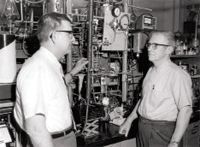
Figure 1: Joseph Jack Kirkland (left) with his lab technician, Glen Wallace, in front of a prototype HPLC system that Kirkland built in his laboratory. This picture was taken ca. 1968 before there were any commercial HPLC systems available.
Major Scientific Contributions: Kirkland's various accomplishments throughout his 60+ years in separation science are quite remarkable. He has coauthored eight books, contributed more than 160 papers, been awarded 36 patents, and taught more than 5000 students through the American Chemical Society (ACS). In fact, when Kirkland's friends and colleagues were asked to tell us what his biggest contribution has been, most gave us a long list of items.
"Kirkland has had so many valuable contributions to separation science that it is hard to pick just one," said Kirkland's friend and colleague Joseph J. DeStefano, the president of Advanced Materials Technology. A few of the contributions DeStefano listed included the development of the first spherical packing designed specifically for modern HPLC (the superficially porous particle called "Zipax"), the development of the "Permaphase" siloxane bonded phases on Zipax particles that enabled convenient gradient elution methods and reversed-phase applications, and the establishment of processes for manufacturing spherical small-particle (5 μm), totally porous packings (trade-named Zorbax) that greatly increased resolution and decreased separation times of HPLC columns. "In my mind, HPLC would have taken much longer to develop into a powerful separation tool if Kirkland had not introduced the superficially porous particles to replace totally porous particles for LC and the permanently bonded stationary phases to enable gradient elution and reversed-phase separation technologies."
John G. Dorsey of the Department of Chemistry and Biochemistry at Florida State University also mentioned the Zorbax column as a major contribution from Kirkland. "This is one of the best known brands of columns, and there are likely few chromatographers today who have not used a column that was initially developed by Kirkland," said Dorsey.
John Dolan, the vice president of LC Resources and a longtime LCGC columnist, said if he had to pick one word to describe Kirkland it would be "innovator", saying "I think at this stage that Kirkland has made more contributions to HPLC column technology than any other individual." He explained that Kirkland has progressively improved particle technology, stationary-phase chemistry, and column packing techniques. Kirkland's development of superficially porous particles particularly impressed Dolan. "I believe that in the future this technology will be looked at as the most significant advance in HPLC since the introduction of bonded stationary phases," Dolan stated.
Lloyd R. Snyder, who is retired from LC Resources, has known Kirkland since 1968. Together, Kirkland and Snyder started and taught the ACS short course "Introduction to Modern Liquid Chromatography" and wrote five books over the years. Snyder and Dolan once wrote that Horváth, Huber, and Kirkland could be considered as the "fathers" of HPLC.1 Snyder even said that Kirkland's contributions to the development of HPLC match or exceed that of the other two in the HPLC "holy trinity" and "go far beyond any living chromatographer".
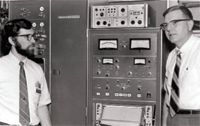
Figure 2: Kirkland (right) with a colleague, Bob Leitch, in front of the first commercial HPLC system manufactured by the DuPont Company (Model 820, serial number 1). This picture is ca. 1970.
Barry Karger, the director of the Barnett Institute and James L. Waters Chair at Northeastern University, agrees that Kirkland is one of the fathers of HPLC. Karger also said that there is no question that Jack was and remains a major figure in particle design for optimum chromatographic separations. "From the earliest days of pellicular particles to the latest core–shell low-micrometer-sized particles, Kirkland led the way," he said.
Snyder also mentioned Kirkland's development of coated small particles ("Halo") that were introduced in the mid-2000s. These columns nearly doubled the efficiency (N values) of conventional columns. "This development revolutionized everyday practice and provided a useful alternative to more expensive and demanding ultrahigh-pressure operation," said Snyder.
Kirkland also played a key role in the development of the hydrophobic-subtraction model of reversed-phase column selectivity. "This work eventually resulted in a US Pharmacopeia database that allows more than 600 columns to be compared in terms of selectivity," said Snyder.
Dolan also commented on Kirkland's contribution to the hydrophobic–subtraction model project. During the development of the model, Dolan's group was studying the effect of the density of surface coverage on retention, and it was difficult to do that without carefully matched columns of the same chemistry on the same silica, differing only in bonding density. "Kirkland specially prepared a set of columns differing only in bonding density and supplied several of each type for us to use, streamlining our research immensely," said Dolan.
Peter Carr, a professor of chemistry at the University of Minnesota, feels that Kirkland's contribution to the international meetings on HPLC played a vital role in keeping that meeting the premier conference in the field. "There is no doubt that without Kirkland's many contributions, HPLC would not be in the advanced state of development that it is today," he said.
Mark R. Schure, the chief technology officer at Kroungold Analytical, Inc., said that Kirkland's work with field-flow fractionation (FFF) was also very important. "He developed the time-delayed exponential field programme for sedimentation FFF amongst other contributions to FFF," he said.
The late Georges Guiochon summed up Kirkland's major contributions best: "Kirkland has a profound knowledge of all practical aspects of chromatography and was able to make wonderful materials for chromatographic columns."
Teaching and Writing Contributions: Kirkland's passion for advancing chromatography by creating new products led to a passion for sharing his knowledge. "Besides these major product developments, Kirkland has contributed to the scientific community by helping to educate future generations of chromatographers through his books, lectures, scientific publications, and teaching courses," said DeStefano.
Bob Moody, who is retired from MAC-MOD Analytical, Inc., agreed that Kirkland's "enthusiasm for sharing his knowledge through teaching, publishing, and presenting his ideas at conferences and meetings" might be his greatest contribution to the field.

Figure 3: Kirkland with Wallace Yau working on a prototype sedimentation field flow fractionator. This picture was taken in the late 1980s.
Through their ACS short courses, "Introduction to Modern Liquid Chromatography" and "Practical HPLC Method Development", Snyder and Kirkland - later joined by Dolan and Joseph L. Glajch - taught thousands of students over the years.
Glajch, who is now director of analytical development at Momenta Pharmaceuticals, called Kirkland an "outstanding teacher" both in formal courses and individual sessions. "He had a unique ability to focus and teach the critical aspects of chromatography that was understandable to all," Glajch said.
Klaus K. Unger, a professor at Johannes-Gutenberg University, had similar comments. "Due to his rich experimental and long-standing knowledge in the field, Kirkland always gave clear and understandable presentations with take-home messages that the user could apply to their daily work," Unger said. "There are very few people that have this attitude and calibre."
The ACS course also led to the first book by Kirkland and Snyder, Introduction to Modern Liquid Chromatography (1974), often referred to as "The Bible" by many chromatographers. The book is now in its third edition, with John Dolan as an additional coauthor.
This book has impacted so many thousands of practitioners, said Dorsey, that "Snyder and Kirkland" is an accepted reference in chromatography and their names are irrevocably linked. "For curiosity, I typed 'Snyder and Kirkland' into Google, in quotation marks, so that only that phrase appeared, and I got about 14,600 results," he said.
Carr agrees. "There is no question that this monograph had a huge impact on the field of HPLC," he said. "It helped HPLC move very rapidly into research labs in academia and industry, and then into more routine analysis laboratories in industry."
"It is rare to go into a laboratory anywhere in the world and not see a copy of this book on the shelf," added Dolan. "It sold more than 22,000 copies, which set some kind of record for a scientific reference book."
The book has also stood the test of time. "The 'Bible' simply remains the Bible," said Frantisek Svec, recently retired from the Molecular Foundry at E.O. Lawrence Berkeley National Laboratory. "I have the newest edition on my bookshelf," he said. At Pittcon 2010, Svec met up with all three authors of the third edition (Dolan, Kirkland, and Snyder) and asked them to sign his copy. "When I opened the book later, I read the dedication: 'Frank, I hope you got your money's worth! With very best wishes,' followed by the three signatures," said Svec. "I still have the book and I'm proud that it includes the dedication."
An Inspirational Scientist, Mentor, and Collaborator: So many of Kirkland's friends and colleagues said that he was an inspiration to them. "Not only has he unselfishly shared his knowledge with other scientists working in the field, but his enthusiasm has inspired several new generations of separation scientists," said Moody.
"I still recall reading - and rereading - a paper by Kirkland2 when I was a graduate student in the late 1970s," said Dorsey "That paper laid the foundation for problems people are working on now, showing how important minimizing extracolumn effects is in achieving maximum column performance." Dorsey noted that the same paper also alerted scientists to the problem that the universally used Gaussian-based equations for plate counts are grossly inaccurate for asymmetric peaks. "A few years later I showed that paper to one of my first graduate students, Joe Foley, and that led to our development of what is known as the Foley-Dorsey equation for plate counts that gives accurate efficiency data for both Gaussian and skewed peaks," said Dorsey.
Wolfgang Lindner, of the Institute of Analytical Chemistry at the University of Vienna, said that Kirkland had a big impact on his career because his scientific and human credibility were always a very positive example. "His pioneering spirit inspired me and many other people around the world," he said.
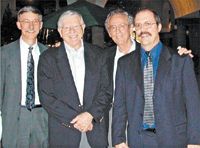
Figure 4: The lecturers for the Introduction to Modern LC ACS course. From left to right: John Dolan, Kirkland, Lloyd Snyder, and Joseph Glajch.
Snyder echoed that sentiment. "Kirkland continues to provide ideas, inspiration, and leadership for everything he is associated with," he said. "I have witnessed this first-hand as well as his strong sense of the right way to do things."
Glajch was mentored by Kirkland and agrees that his teaching and willingness to help other scientists is another one of his great contributions. "His keen understanding of the fundamentals of LC was critical, but Kirkland also recognized the need to collaborate with others in the field of statistical design to design an organized approach to method development," said Glajch. Working in this way gave Kirkland the ability to expand his reach and work in a truly collaborative way Glajch explained.
Indeed, Kirkland collaborated with a number of other scientists over the years. DeStefano mentioned Kirkland's work with visiting scientists such as Jürgen Köhler to develop the first "Type B" silica support that "vastly reduced the acidity of silica surfaces and improved the HPLC of basic compounds". He also worked with Wallace Yau to develop the concept of using bimodal pore size packing materials for performing size-exclusion chromatography (SEC) over four orders of magnitude in solute size.
"One of Kirkland's biggest strengths as a mentor and coworker is that he always went out of his way to make sure people who worked with him received credit and recognition for their work," Glajch said.
DeStefano, who was also mentored by Kirkland, saw Kirkland help many people in the companies he worked for to solve problems and establish their scientific careers. "His imposing presence and leadership skills provide encouragement for success among all the scientific relationships he has formed during his career," DeStefano said.
Awards: Kirkland has been the recipient of many prestigious awards for his work, such as the ACS Award in Chromatography, DuPont's Lavoisier Medal, the Swedish Torbern Bergman Medal, the A.J.P. Martin Chromatography Medal, the CASSS Scientific Achievement Award, and the 2013 U.D. Neue Award in Separation Science - just to name a few.
Kirkland's colleagues expressed why he was deserving of the LCGC Lifetime Achievement Award as well. "He represents the best example of the unique combination of both worlds, academia and industry, which is so rare today," said Svec.
Dolan is pleased to see Kirkland receive this award, explaining that too often rewards are only given to academics. "Kirkland chose to spend his entire career in industry, yet has contributed more than most academics to the understanding of the chromatography process and the practical application of it to real-life problems," Dolan said.
"It is also gratifying to know that someone who has been such a good role model, not only for his considerable accomplishments, but also for setting and achieving such high ethical standards in his professional and personal life is being recognized," Moody added.
DeStefano said that Kirkland's philosophy about research is best expressed when he says to others: "There is no such thing as a bad experiment. Even if you fail to achieve what was expected, you have learned something by doing it."
Indeed, Kirkland seems to exemplify Blake's quote, having "proven" so many of the concepts that he "imagined", and his success deserves to be celebrated.
The winner of the LCGC 2015 Emerging Leader in Chromatography Award, Caroline West, will be featured in an upcoming issue of The Column.
References
1. L.R. Snyder and J.W. Dolan, Handbook of Separation Science: Liquid Chromatography (Elsevier, Amsterdam, 2012), Chap. 1.
2. .J. Kirkland, J. Chromatogr. Sci.15, 303–316 (1977).
Meg L'Heureux is the Managing Editor of LCGC North America.
E-mail: mlheureux@advanstar.com
Website: www.chromatographyonline.com
This article is from The Column. The full issue can be found here>>
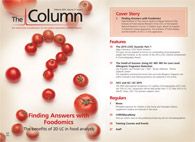
Polysorbate Quantification and Degradation Analysis via LC and Charged Aerosol Detection
April 9th 2025Scientists from ThermoFisher Scientific published a review article in the Journal of Chromatography A that provided an overview of HPLC analysis using charged aerosol detection can help with polysorbate quantification.










